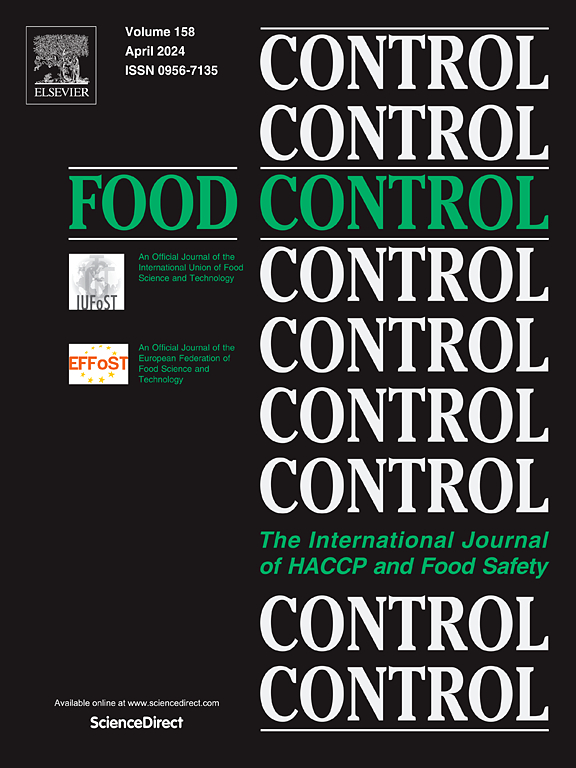2021 - 2023年福建省鱼类麻醉药残留及健康风险评价
IF 5.6
1区 农林科学
Q1 FOOD SCIENCE & TECHNOLOGY
引用次数: 0
摘要
麻醉药广泛用于鱼类养殖和运输,以减少应激反应,最大限度地减少死亡和伤害。然而,过度使用威胁着人类健康。本研究旨在分析福建省鱼类中麻醉药残留状况,评估麻醉药在鱼类中的健康风险。采用超高效液相色谱-串联质谱(UPLC-MS /MS)对福建省2021 - 2023年采集的368份鱼类样品进行分析,研究了3种麻醉药的残留特征。此外,膳食暴露风险评估采用终点评估模型进行。3种麻醉药中仅检出丁香酚,总检出率为49.5%,超标率为33.2%。检出率和超标率呈逐年下降趋势。不同地区的发病率差异较大,以厦门最高。从商店购买的样本的检出率和超标率最高。不同鱼类的丁香酚残留量不同,罗非鱼、鲈鱼、鲫鱼和草鱼的检出率最高(≥70.4%)。多变量分析表明,丁香酚残留量与鱼类和地理区域之间存在显著相关性。危害商(HQ)低于1,表明食用当地淡水鱼的急性健康风险有限,但需要进一步注意。本研究率先开展了福建省3年鱼类麻醉残留监测和膳食丁香酚暴露评估,为今后监测奠定基础,保护消费者健康。本文章由计算机程序翻译,如有差异,请以英文原文为准。
Residues and health risk assessment of anesthetic in fish in Fujian Province of China from 2021 to 2023
Anesthetics are widely used in fish farming and transport to reduce stress responses and minimize mortality and injury. However, overuse threatens human health. This study aims to analyze the residual status of anesthetics in fish in Fujian Province and estimate the health risks caused by anesthetics in fish. A total of 368 fish samples collected from the Fujian Province of China from 2021 to 2023 were analyzed by ultra-high performance liquid chromatography-tandem mass spectrometry (UPLC–MS/MS) to study the residue profiles of three anesthetics. In addition, the dietary exposure risk assessment was performed using an end-point assessment model. Among the three anesthetics, only eugenol was detected, with an overall detection rate of 49.5 % and an exceedance rate of 33.2 %. The detection rate and exceedance rate exhibited a declining trend annually. Geographical variation was observed, with Xiamen having the highest rates. Samples purchased from shops showed the highest detection and exceedance rates. Different fish species exhibited varying eugenol residuals, with tilapia, perch, crucian, and grass carp having the highest detection rates (≥70.4 %). The multivariable analysis revealed significant associations between eugenol residue levels and both fish species and geographic regions. The hazard quotient (HQ) was lower than 1, suggesting limited acute health risks from consuming local freshwater fish, but further attention is needed. This study pioneers the monitoring of anesthetic residuals in fish samples from Fujian over three years and the assessment of dietary eugenol exposure, laying a foundation for future monitoring and thus protecting the health of consumers.
求助全文
通过发布文献求助,成功后即可免费获取论文全文。
去求助
来源期刊

Food Control
工程技术-食品科技
CiteScore
12.20
自引率
6.70%
发文量
758
审稿时长
33 days
期刊介绍:
Food Control is an international journal that provides essential information for those involved in food safety and process control.
Food Control covers the below areas that relate to food process control or to food safety of human foods:
• Microbial food safety and antimicrobial systems
• Mycotoxins
• Hazard analysis, HACCP and food safety objectives
• Risk assessment, including microbial and chemical hazards
• Quality assurance
• Good manufacturing practices
• Food process systems design and control
• Food Packaging technology and materials in contact with foods
• Rapid methods of analysis and detection, including sensor technology
• Codes of practice, legislation and international harmonization
• Consumer issues
• Education, training and research needs.
The scope of Food Control is comprehensive and includes original research papers, authoritative reviews, short communications, comment articles that report on new developments in food control, and position papers.
 求助内容:
求助内容: 应助结果提醒方式:
应助结果提醒方式:


